SedimentCurrent use pesticides (µg/kg dry weight)
|
MusselsCurrent use pesticides (µg/kg wet weight)
|
|
|---|---|---|
|
|
North |
|
| South |
What are they?
Current use pesticides (CUPs) are a diverse group of chemicals that are currently used in Canada and elsewhere for pest control. They were developed as a result of bans and restrictions on most organochlorine pesticides in the 1970s and 1980s. CUPs were developed to be less persistent. In British Columbia, CUPs are used mainly in agriculture, forestry, and for urban use.
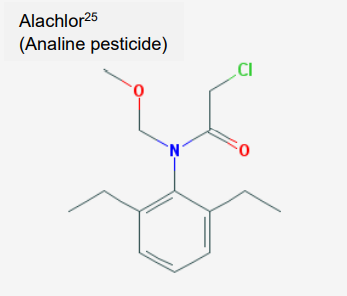
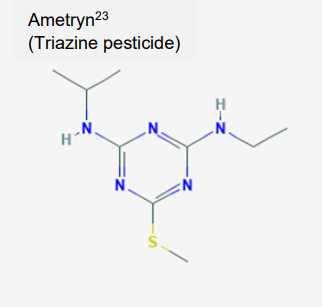
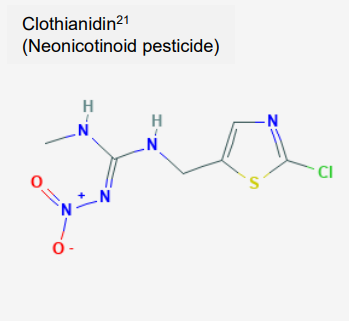
Which ones were detected?
CUPs detected in Phase 1 of Pollution Tracker (2015-2017) are summarized in Table 1.
Table 1. Current use pesticides detected in Phase 1
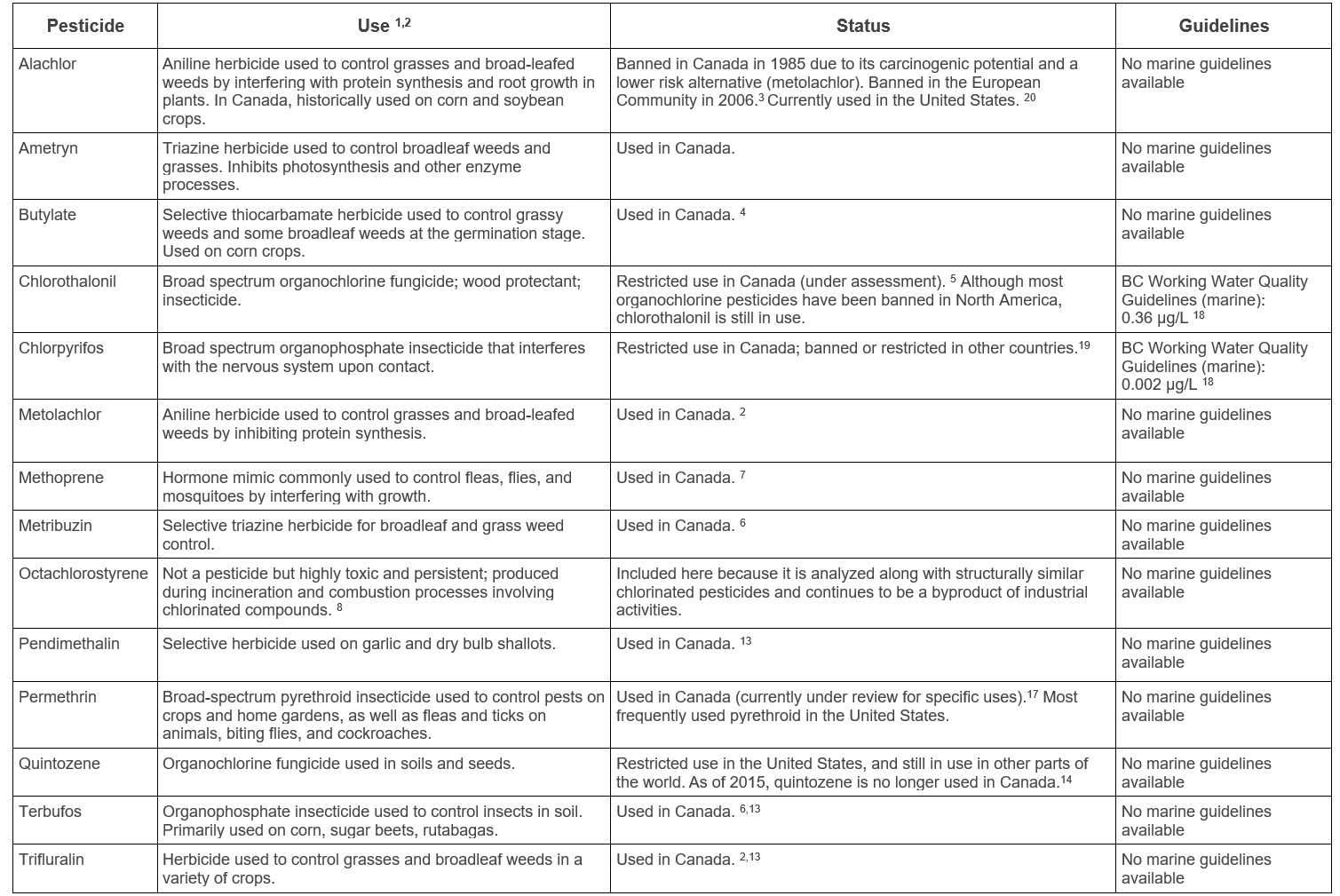
Additional CUPs detected in Phase 2 (2018-2020) are shown in Table 2.
Table 2. Additional Current Use Pesticides detected in Phase 2
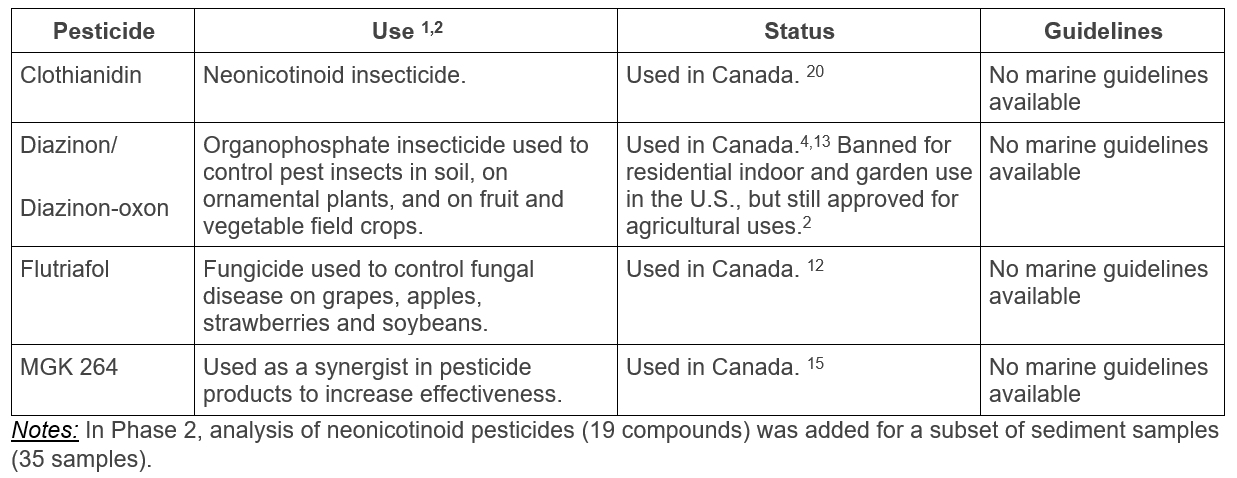
FACT: Neonicotinoid pesticides (neonics) are the most widely used class of insecticides world-wide. Neonics such as clothianidin are harmful to non-target aquatic and terrestrial insects such as bees and other pollinators. The use of neonics was re-evaluated by Health Canada in 2019, which resulted in the mitigation and restriction of certain applications.16
How do they get into the ocean?
Current use pesticides typically enter the aquatic environment via surface runoff from treated areas, stormwater discharges, groundwater infiltration, and atmospheric deposition. Pesticides may also be applied directly to freshwater aquatic systems intentionally (e.g., for control of mosquito larvae) or unintentionally during aerial application of pesticides to forested and agricultural areas.9
A 2008 study showed that complex mixtures of pesticides are present in urban, agricultural, and remote areas of British Columbia, and that mixtures of legacy and current use pesticides were detected at all sites. However, at all sites, legacy pesticides were dominant in biota (tissue) while CUPs were dominant in water samples.9
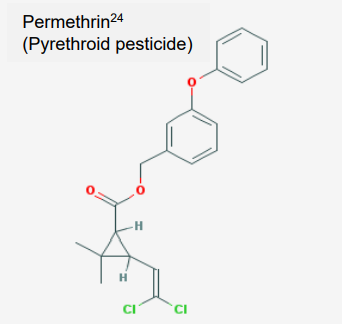
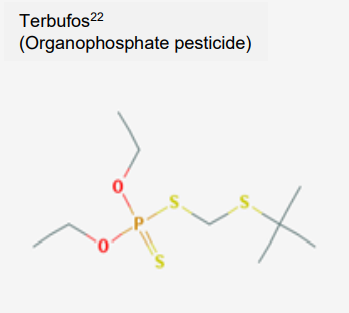
Are they a problem?
In general, CUPs are more target-specific and less persistent than legacy pesticides, but some CUPs (e.g., organophosphates) are more acutely toxic.10 Given the number and diversity of CUPs, as a group they have the potential to cause adverse effects on a wide range of organisms. Effects observed in non-target organisms include neurotoxicity, disruption of growth and development, suppression of the immune system, interference with kidney function, and disruption of a range of other protein, enzyme, and hormone processes.9
Despite the development of less toxic CUPs, these alternatives are often more expensive and are not as widely used. For example, synthetic pyrethroids are based on natural insecticides from chrysanthemum flowers and were developed as a less toxic alternative to organophosphates. However, they are often not used in poorer regions of the world due to their cost.10
In addition to the inherent toxicity of pesticides while in use, stockpiled pesticides pose an additional risk to human health and the environment world-wide. Stockpiles may hold pesticides that are obsolete due to regulatory bans, or that have expired. Containers may corrode and leak, and chemical by-products that form as pesticides deteriorate can be more toxic than the original products.10
What is being done?
Health Canada controls the import, sale, manufacture, and use of pesticides in Canada. Provincial pesticide regulations further control how pesticides are sold, used, applied, and licensed, and municipal governments may also enact bylaws restricting pesticides use.4
Canadian environmental water quality guidelines for the protection of aquatic life have been developed for some CUPs, but marine sediment quality guidelines and tissue residue guidelines for the protection of wildlife consumers of aquatic biota are not available.
One of the most publicized health concerns associated with CUPs is their detection in drinking water. Canada and other countries have developed drinking water quality guidelines for some of the most frequently detected CUPs. In 2003, the European Union banned atrazine, one of the world’s most widely used herbicides, due to concerns about contamination of groundwater used for drinking water. However, following assessments, the United States and Canada continue to allow atrazine use.
Under the umbrella of the United Nations, the Rotterdam Convention identifies hazardous chemicals, including pesticides, that require regulations around their import and export. Member nations, including Canada, must conform with export rules about labeling, safe handling, and identification of any known restrictions or bans, and can decide whether to allow or ban import of these chemicals. Of the CUPs detected in Pollution Tracker samples, only alachlor is listed under the Rotterdam Convention.11
What can you do?
As individuals and organizations we can:
- Learn more about current use pesticides using the resource links below
- Reduce or eliminate the use of chemical pesticides around the household and garden
- Wash fruits and vegetables before eating them
- Avoid areas that have recently been sprayed with pesticides
- Recycle and dispose of waste according to local regulations
More Information?
1 Extension Toxicology Network (EXTOXNET). Pesticide Information Profiles. Available at: Pesticide Information Profiles (orst.edu)
2 Agency for Toxic Substances and Disease Registry (ATSDR). Available at: https://www.atsdr.cdc.gov/
3 Rotterdam Convention. 2011. Decision Guidance Document. Alachlor. Available at: http://www.pic.int/Portals/5/DGDs/DGD_Alachlor_EN.pdf
4 Environment and Climate Change Canada (ECCC). 2011. Presence and levels of priority pesticides in selected Canadian aquatic ecosystems. Available at: PRESENCE AND LEVELS OF PRIORITY PESTICIDES IN SELECTED CANADIAN AQUATIC ECOSYSTEMS (canada.ca)
5 Health Canada. 2016. Amendment to the proposed Re-evaluation decision of chlorothalonil, reevaluation note REV2016-06, Available at: https://www.canada.ca/en/health-canada/services/consumer-product-safety/pesticides-pest-management/public/consultations/re-evaluation-note/2016/amendment-proposed-evaluation-decision-chlorothalonil.html
6 Health Canada. 2019. Guidelines for Canadian Drinking Water – Summary Table. Water and Air Quality Bureau, Healthy Environment and Consumer Safety Branch. Available at: sum_guide-res_recom-eng.pdf (canada.ca)
7 Health Canada. 2016. Registration Decision. (S)-Methoprene. Available at: https://www.canada.ca/en/health-canada/services/consumer-product-safety/reports-publications/pesticides-pest-management/decisions-updates/registration-decision/2016/methoprene-rd2016-06.html
8 Chu S, Covaci A, Voorspoels S, Schepens P. 2003. The distribution of octachlorostyrene (OCS) in environmental samples from Europe. Journal of Environmental Monitoring 5(4): 619-25.
9 Garrett C and Ross PS. 2010. Recovering resident killer whales: a guide to contaminant sources, mitigation, and regulations in British Columbia. Canadian Technical Report of Fisheries and Aquatic Sciences 2894.
10 Food and Agriculture Organization of the United Nations (FAO). 2017. Prevention and Disposal of Obsolete Pesticides. Available at: http://www.fao.org/agriculture/crops/obsolete-pesticides/what-dealing/obs-pes/en/
11 Rotterdam Convention. 2017. Annex III Chemicals. Available at: http://www.pic.int/TheConvention/Chemicals/AnnexIIIChemicals/tabid/1132/language/en-US/Default.aspx
12 Health Canada. 2015. Registration decision RD2015-06, flutriafol. Available at: https://www.canada.ca/en/health-canada/services/consumer-product-safety/reports-publications/pesticides-pest-management/decisions-updates/registration-decision/2015/flutriafol-rd2015-06.html
13 Health Canada. 2012. Maximum Residue Limits for Pesticides. Available at: https://pr-rp.hc-sc.gc.ca/mrl-lrm/index-eng.php.
14 Health Canada. 2016. Re-evaluation Note REV2016-01, Special Review Decision: Quintozene. Available at: Re-evaluation Note REV2016-01, Special Review Decision: Quintozene – Canada.ca
15 Health Canada. 2019. Re-evaluation decision RVD2019-10, n-octyl bicycloheptene dicarboximide (MGK-264) and its associated end-use products. Available at: https://www.canada.ca/en/health-canada/services/consumer-product-safety/reports-publications/pesticides-pest-management/decisions-updates/reevaluation-decision/2019/n-octyl-bicycloheptene-dicarboximide.html
16 Health Canada. 2019. Re-evaluation Decision RVD2019-05, Clothianidin and Its Associated End-use Products: Pollinator Re-evaluation Re-evaluation Decision RVD2019-05, Clothianidin and Its Associated End-use Products: Pollinator Re-evaluation – Canada.ca
17 Health Canada. 2017. Proposed re-evaluation decision PRVD2017-18, permethrin and its associated end-use products. Available at: Proposed Re-evaluation Decision PRVD2017-18, Permethrin and Its Associated End-use Products – Canada.ca
18 British Columbia Ministry of Environment and Climate Change Strategy. 2021. Working Water Quality Guidelines: Aquatic Life, Wildlife & Agriculture.Water Quality Guideline Series, WQG-08. Prov. B.C., Victoria B.C. Available at: https://www2.gov.bc.ca/assets/gov/environment/air-land-water/water/waterquality/water-quality-guidelines/bc_env_working_water_quality_guidelines.pdf
19 Health Canada. 2020. Re-evaluation Decision RVD2020-14, Chlorpyrifos and Its Associated End-use Products (Environment). Available at: https://www.canada.ca/en/health-canada/services/consumer-product-safety/reports-publications/pesticides-pest-management/decisions-updates/reevaluation-decision/2020/chlorpyrifos.html
20 United States Environmental Protection Agency (US EPA). 1998. Reregistration Eligibility Decision (RED) Alachlor. EPA 738-R-98-020. Available at: https://www3.epa.gov/pesticides/chem_search/reg_actions/reregistration/red_PC-090501_1-Dec-98.pdf
21 PubChem Identifier: CID 86287519 URL: Clothianidin | C6H8ClN5O2S – PubChem (nih.gov)
22 PubChem Identifier: CID 25670 URL: Terbufos | C9H21O2PS3 – PubChem (nih.gov)
23 PubChem Identifier: CID 13263 URL: Ametryn | C9H17N5S – PubChem (nih.gov)
24 PubChem Identifier: CID 40326 URL: Permethrin | C21H20Cl2O3 – PubChem (nih.gov)
25 PubChem Identifier: CID 2078 URL: Alachlor | C14H20ClNO2 – PubChem (nih.gov)